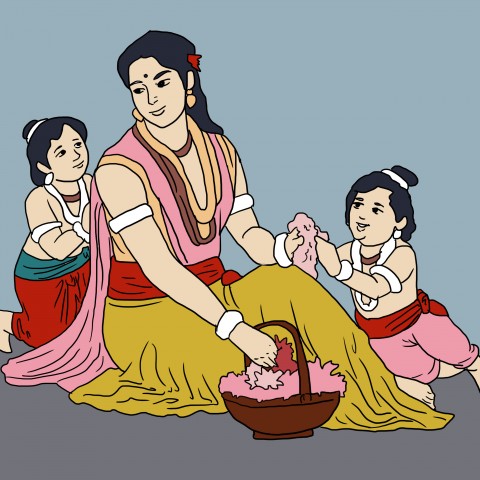
Walang iwanan. There’s probably no other Filipino value that will make you love the Philippines and its people more than the one represented by this expression. It basically means that no one is left behind.
And that’s what Filipinos are all about. Pinoys stick together as a people, which is why you’ll find a Filipino community in nearly every corner of the world. Perhaps this makes saying goodbye in Tagalog that much more significant.
Despite the fact that Filipinos always stick together, they’re also the ones who say goodbye to each other the most. Every year, more than a million Pinoys leave the country to live and work in a foreign land—and every day, families say goodbye to each other. But as the saying goes, “No goodbyes; only see you later.”
But how exactly do Filipinos say goodbye to each other? In this article, you’ll discover the top fifteen ways to say goodbye in Filipino. Start with a bonus, and download the Must-Know Beginner Vocabulary PDF for FREE! (Logged-In Member Only)
 Table of Contents
Table of Contents
- Common Ways to Say Goodbye in Tagalog
- Specific Ways to Say Goodbye
- Untranslatable Goodbye Phrases in Filipino
- The FilipinoPod101 Advantage
1. Common Ways to Say Goodbye in Tagalog

Filipinos are known for their hospitality, so the value they place on politeness should come as no surprise. When we speak of being polite and courteous, that includes knowing when and how to greet others, as well as how to ask permission when it’s time to go. Below are some of the most common ways to say goodbye in the Filipino language.
1. Paalam. / “Goodbye.”
“Goodbye” in Tagalog is paalam. This is a formal way to bid someone farewell in Filipino, so you won’t often hear it in conversations. Instead, you’re more likely to hear it in movies and read it in Filipino literature. You’ll also hear it in songs, such as in the classic OPM song Paalam Na by Rachel Alejandro. The chorus of the song goes:
- Paalam na aking mahal, kay hirap sabihin. / “Goodbye, my love; such difficult words to say.”
2. Hanggang sa muli. / “Until next time.”
Hanggang sa muli is the Tagalog expression for “Until next time,” with hanggang being “until” and sa muli being “again.” Like paalam, this is a formal Filipino goodbye.
Keep in mind that “next time” is actually sa susunod in Tagalog, so it’s also correct to say: Hanggang sa susunod.
This phrase is often used as a follow-up to paalam, which is why it’s not uncommon to hear or read:
- Paalam. Hanggang sa muli. / “Goodbye. Until next time.”
Interestingly, this is something you also see in English grammar.
3. Hanggang sa muling pagkikita. / “Until we see each other again.”
Like the previous two examples, this phrase is rarely used in conversational Tagalog, and is more common in songs and literature. Hanggang sa muling pagkikita means “Until we see each other again,” and it’s just another way of saying: Hanggang sa muli nating pagkikita. / “Until our next meeting.”
4. Babay! / “Buh-bye!”
Babay is the equivalent of the English words “buh-bye” or “bye bye.” In contrast to the first three words, this one is used only when you’re comfortable with or close to the person you’re saying goodbye to. That said, you don’t say this to your boss or to one of your clients. In fact, in the Philippines, this word is mainly used by little kids or parents saying goodbye to their children before leaving for work.
5. Bye!
Yes, many Filipinos actually use the English word “bye” instead of the Tagalog equivalent. English is a second language to most Filipinos, so it’s not surprising that most people in the Philippines use a lot of English words in their conversations. In fact, you’ll rarely hear a Filipino person nowadays conversing in pure Tagalog.
In the Philippines, there’s a subculture referred to as “conyo.” This refers to Tagalog-speaking people who, when speaking in English, insert one or two Tagalog words into their sentences, all the while speaking with a heavy American accent.
One example is “It’s so traffic naman today,” which, when translated, means: “The traffic is unusually heavy today.”
In regular Tagalog conversations, though, it’s not unusual to hear someone saying:
- Bye, mauna na ako. / “Bye, I’m leaving now.”

“It’s so traffic naman today.”
- → Have you checked out our entry on basic Filipino greetings?
2. Specific Ways to Say Goodbye
Now, let’s discover how Filipino people say goodbye in more specific contexts.
6. Huwag magpagabi ha? / “Don’t stay out too late, okay?”
The conservativeness of the Filipino people is evident in the way they speak. This is clear, for example, in how Filipinos often speak to their loved ones. Huwag magpagabi is often said by strict parents or elders to remind their young ones that while they’re free to spend time with their friends, they’re still expected to come home before it gets dark.
A: ‘Nay, alis na po ako. / “Ma, I’m leaving now.”
B: Sige. Huwag magpagabi ha? / “Sure. Don’t stay out too late, okay?”
7. Uwi kaagad ha? / “Be home as soon as possible, okay?”
Under Philippine Law, a person under the age of eighteen years old is still considered a child. But in many Filipino homes, it’s still very common to hear a parent bid their twenty-five-year-old daughter: Uwi kaagad ha? It’s like the Filipino way of saying goodbye, but not really. It’s like saying goodbye to the other person, but deep in your heart, you don’t want them to leave the house at all. Uwi, by the way, is short for umuwi, or “to come home.”
A: ‘Nay, alis na po kami ng mga kaibigan ko. / “Ma, I’m leaving with my friends now.”
B: Sige. Uwi ka kaagad ha? / “Sure. Be home as soon as possible, okay?”
8. Ingat! / “Take care!”
This Filipino word for goodbye translates to “care.” When using it to say goodbye, it’s actually short for Mag-ingat ka, meaning “You take care” or simply “Take care.” It’s used all the time as a way to wish the other person well or to tell them to take care of themselves. This is especially true if the person is embarking on a long journey or traveling at night. As a reply, you could simply say Ikaw rin or “You, too.”
- → Speaking of taking care of one’s self, make sure to check out our lesson on how to give warnings and cautions.

Papayagan kitang mamasyal, basta uwi ka kaagad ha?
(“I’ll let you go out with your friends, but promise me you’ll be home early, okay?”)
9. Mauna na ako. / “I gotta run.”
Mauna na ako is used to say that you need to leave. Most Filipinos incorrectly translate this to “I’ll go ahead,” which doesn’t have any use in the Filipino language at all. In Filipino, the phrase “go ahead” is actually sige. Mauna, on the other hand, means “to go first” or “to be the first.” In the context of saying goodbye, it means to be the first to leave or that someone is leaving already.
Mauna na ako basically means any of the following:
“I gotta run.”
“I have to run along.”
“I should be running along.”
“It’s time I ran along.”
- Guys, mauna na ako para makaiwas sa traffic. / “Guys, I should be running along, or I’m going to have to deal with heavy traffic.”
10. Diyan ka na muna. / “I gotta leave you for a while.”
Another way to say goodbye in Tagalog is: Diyan ka na muna. Most Filipinos say this when they’re in a hurry to leave. It’s like when you’re having a conversation with a friend and then you suddenly receive a text message that there’s an emergency, or you suddenly remember something that you have to do quickly.
Naku! Kailangan ko palang bumili ng gamot. Diyan ka na muna. / “Oh my! I forgot that I need to get some medicine. I gotta leave you for a while.”

Mauna na ako. Manonood pa ako ng Ang Probinsyano.
(“I gotta run. It’s time for my favorite primetime show—Ang Probinsyano.”)
11. Iwan na muna kita diyan ha. / “I’ll leave you here for a while, okay?”
This is a more polite way of saying the previous expression. While diyan ka na muna is proper, if it’s not put into context, it could sound a bit rude. So, if you want to play it safe, you can say: Iwan na muna kita diyan.
- Ay, nag-text ang boss ko. Emergency daw. Iwan na muna kita diyan ha? / “Oh, my boss texted me. He said it’s an emergency. Is it okay if I leave you here for a while?”
Notice the difference?
12. Kitakits! / “See you around!”
This Filipino term for goodbye is slang for “See you around” or “See you later.” It’s short for Kita-kita na lang, with kita being the Tagalog word for “to see.” Kita-kita na lang tayo is like saying:
“Let’s just see each other around.”
“Let’s meet again sometime.”
- Sige, mauna na kami. Kitakits na lang sa susunod na reunion. / “We gotta run, guys. See you again at our next reunion.”
- → Don’t forget to check out our lesson on the essential vocabulary related to traveling!
3. Untranslatable Goodbye Phrases in Filipino
One of the most unique things about the Filipino language is that it’s rich with words and phrases that don’t have an equivalent in other languages (particularly English). The following are a few untranslatable goodbye phrases in Tagalog.
13. Sige.
The word sige can be directly translated as “sure” or “go ahead,” but in many cases, Filipinos use it as a way of saying goodbye. In such a context, it could mean “go on” when addressing another person. It could also mean “I’m leaving now.” Sige can also be used on its own when someone is acknowledging a person who’s asking permission to leave.
A: Pare, mauna na ako. / “Hey mate, I gotta run.”
B: Sige. / “Sure.”
It can also be used as an introductory word when asking permission to leave:
- Sige, guys. Mauna na ako. / “Alright, guys. I’m leaving now.”
Some people use it to get out of an awkward situation, like when you’re stuck in a conversation with someone you don’t really want to be chatting with. You can say sige and simply walk away.

Uhm…sige.
14. O siya, siya.
This is an expression often used by the elderly. Perhaps it’s derived from Siya nawa, which basically means “Amen” or “So be it.” Sometimes, only one siya is used:
- O siya, mauna na kami. / This could mean: “I guess we should go now.”
Siya is doubled only for emphasis. In response to the above statement, one could say:
- O siya, siya. Mag-ingat kayo ha? / “Alright then. You take care of yourselves, okay?”
15. O, paano?
The direct translation of the word paano is “how.” In the context of saying goodbye, it doesn’t make sense to ask “How?” but Filipinos use it to say something along the lines of “What now?” It’s like saying goodbye and expecting an acknowledgment from the other person.
- O, paano? Alis na ako. / “So, what now? I should be running along.”
4. The FilipinoPod101 Advantage
By now, you should have a better idea of how to say goodbye in Filipino. However, if you want to go deeper with your studies of important Filipino greetings, your best option is to sign up on FilipinoPod101.com. With FilipinoPod101, you’ll have access to tons of lessons with real-life applications.
Add to that our various resources to help you with your vocabulary, comprehension, and pronunciation, and you have the perfect all-in-one study tool.
Need to supercharge your learning? You can take advantage of FilipinoPod101’s MyTeacher feature, a Premium PLUS feature that will help you fasttrack your way to fluency. With this option, you can enjoy one-on-one lessons with a personal teacher, as well as real-time guidance and feedback. This way, you’ll always know whether or not you’re on the right track.
O, paano? Hanggang sa muli! Until our next post!
Don’t forget to let us know in the comments what you think about this lesson, and share with us any questions or additional insight you may have!










